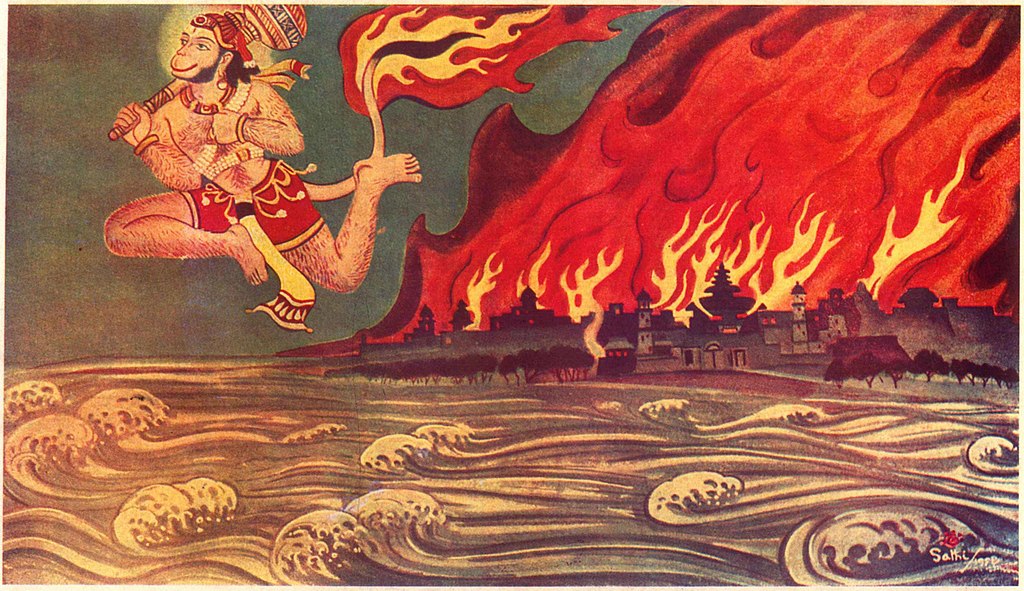
(Continued from Part 4)
In the previous article, we discussed how Rama and His army reached Lanka where a fierce fight ensued between Rakshasas and the monkeys. Both sides suffered heavy losses in the battle. One by one the Rakshasa generals were slain in battle. The atmosphere in the demon camp turned gloomy when Kumbhakarna and Indrajit were also killed. Unable to control his rage, Ravana decided to take the reins into his hand. Encouraged by his ministers, Ravana now wanted to confront Rama, his arch-enemy.
Ravana joins the battle
Ravana was shocked to learn of Indrajit’s demise. He fell to the ground and remained unconscious for some time. Regaining his senses, and raging with anger, Ravana decided to kill Sita. As Ravana rushed to the Ashoka grove, one of his ministers Suparshwa advised him against committing the heinous act. Suparshwa advised that no good can come from killing a woman. Instead, he requested Ravana to direct his wrath towards Rama and Lakshmana, his real enemies. Ravana considered his advice. Overcome by anger and lust, he chose to turn away from Sita. Ravana ordered the Rakshasas to prepare themselves as he was about to join the battle. Ravana mounted his golden chariot that was equipped with all divine weapons and adorned with celestial gems. As the chariot rolled, it thundered like gigantic clouds. Ravana was joined by the last of his remaining generals – Mahaparshwa, Virupaksha, and Surantaka. As Ravana charged into the battle, he observed several inauspicious omens.
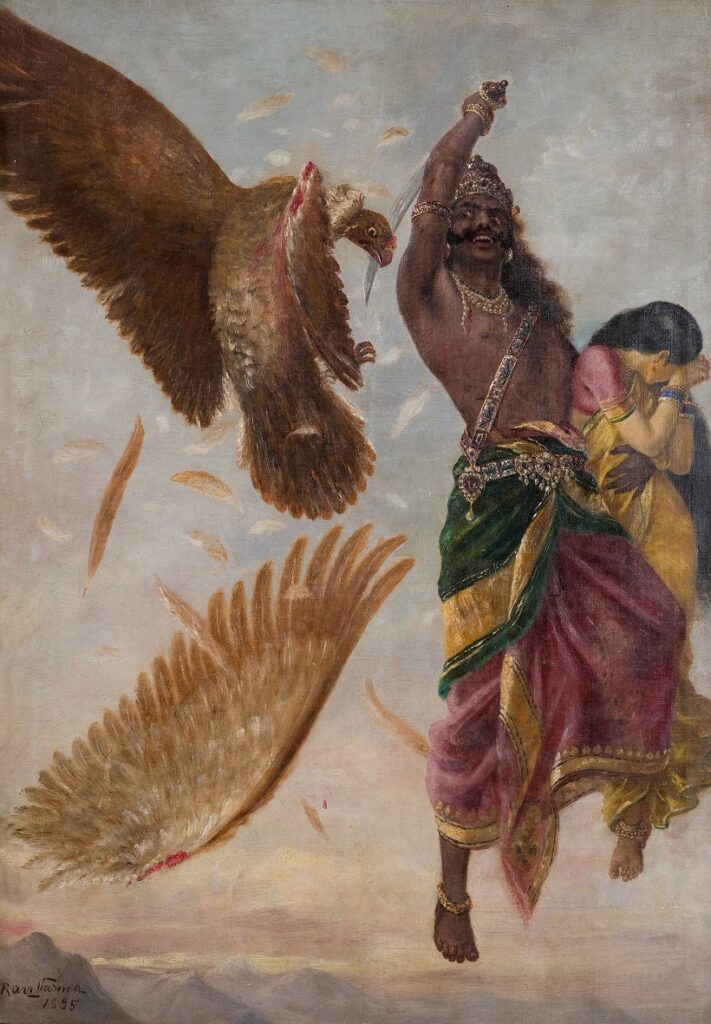
Meanwhile, Rama decided to reveal His full prowess. He cruised like a whirlwind, leaving a trail of slaughtered demons. No one could notice His movements as He fired in all directions from His inexhaustible quiver. He seemed to be everywhere at once and the demons were shot at from all directions. In less than two hours, He had obliterated two hundred thousand Rakshasas along with their eighteen thousand elephants and fourteen thousand horses.
Rama fights with Ravana
Ravana wreaked devastation among the monkeys and started slaughtering them in thousands. The generals of the Rakshasa army confronted the commanders of the monkeys. Virupaksha and Mahaparshwa fought with Sugriva while Surantaka fought with Angada. The Rakshasa generals fought heroically but were slain after intense fights. Ravana was now the only surviving hero of the Rakshasa army. Ravana released a missile presided over by Rahu, that annihilated the monkeys in millions. Witnessing the terror, Lakshmana confronted Ravana and discharged his arrows. Ravana effortlessly cut them into pieces and ignoring Lakshmana, he sped towards Rama. He showered a barrage of arrows upon Rama, who countered them with crescent-headed shafts. Both fighters attacked each other, and the sky was filled with arrows resembling hordes of golden birds.
Ravana fired a series of fearful shafts that pierced Rama’s brow. Rama replied with Rudrastra which pounded Ravana on every part of his body. But Ravana was saved by his celestial armor.
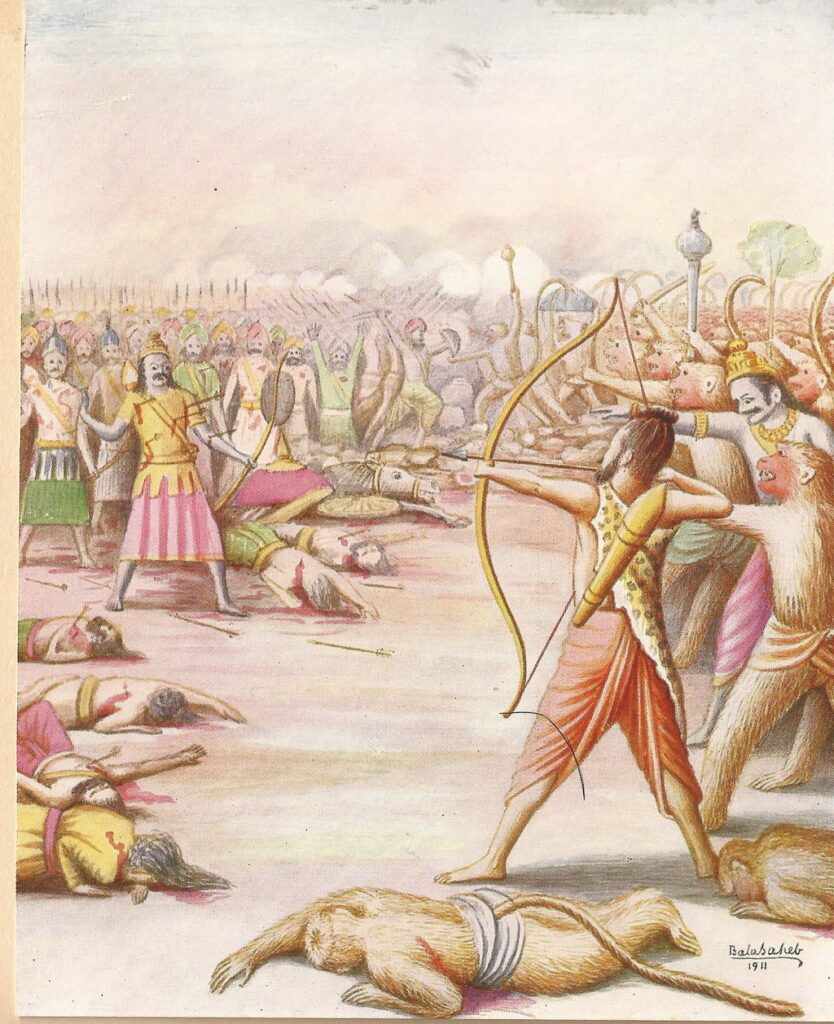
Ravana’s Rakshasa weapon was countered by Rama using Agneyastra. Ravana fired another missile that had been fashioned by Maya, the architect of the asuras. Rama countered it with the Gandharva weapon. In this way, both Rama and Ravana negated each other’s weapons.
Ravana was infuriated witnessing Vibhisana, his brother, fighting for Rama. He hurled a blazing lance towards him. Lakshmana came to his rescue and cut it to pieces with his razor-headed arrows. Ravana took another lance, even more terrible than the previous one, and released it towards his brother. Lakshmana countered this lance with his arrows. An enraged Ravana attacked Lakshmana with his infallible lance. Lakshmana could not defend against it and it struck him full on the chest. Lakshmana collapsed unconscious to the ground.
Rama was shocked to find his brother lying in that state. He gently extracted the lance from Lakshmana’s body and lifted him. Instructing Hanuman to guard Lakshmana’s body, Rama fired an endless stream of ferocious shafts at Ravana. Ravana tried to counter them, but Rama struck more arrows that pierced the demon on every part of his body. Ravana fell back as Rama intensified His attack. As Ravana retreated, Rama ignored the demon and went back to Lakshmana. Rama lamented for some time fearing that his brother was dead. Hanuman called for Sushena, the Vanara physician. He treated Lakshmana with celestial herbs previously fetched by Hanuman. Gradually Lakshmana regained his senses and was brought back to his health.
Rama turned his attention toward Ravana and aimed powerful arrows at the demon. Indra wanted to assist Rama in the battle. He sent his chariot along with Matali, the charioteer, to the battlefield. The chariot was equipped with infallible celestial weapons as well as Indra’s invincible golden armor. It was drawn by a thousand steeds. Rama mounted the chariot and continued His assault on Ravana. When Ravana fired a missile that unleashed thousands of dreadful serpents, Rama countered it with a weapon presided over by Garuda. Golden eagles with sharp beaks and talons quickly dispatched Ravana’s serpents.
Ravana struck Matali and all the steeds. He tore down the golden standard of the chariot. Ravana launched a terrifying assault enwrapping Rama and His chariot with arrows. Matali expertly drove the chariot upwards away from Ravana’s arrows. Ravana hurled a fierce dart towards Rama. The dart could not be defeated with ordinary arrows. Rama countered it with Indra’s Javelin. Rama attacked Ravana with renewed enthusiasm. He invoked all the celestial missiles that tore into Ravana and sent him reeling. The demon was reduced to a sorry plight as he could not even lift his arrow anymore. Seeing that Ravana had sunk to the floor of the chariot, his charioteer steered away from the fight and retreated.

On regaining his senses, Ravana rebuked his charioteer for acting like a coward and for escaping from the fight. The charioteer conveyed that he had no other option witnessing the plight of Ravana. On Ravana’s orders, the charioteer returned to the battlefield where Rama waited for Ravana. Rama and Ravana fought fiercely for hours without interruption. Neither conceded an inch to the other. Never had such a fight been witnessed previously. Rama struck down hundreds of Ravana’s heads but they grew back immediately. No weapon seemed to take his life. Vibhisana then approached Rama and revealed that Ravana had received a boon from Brahma that his heads and arms could never be destroyed. Ravana’s heart was a store of celestial nectar that renewed his life and body. Vibhisana hence suggested that Rama attack Ravana’s heart to dry up the nectar. Accordingly, Rama recalled the celestial arrow that sage Agastya had previously gifted to Him in the forest. The shaft was made of ether and its weight consisted of the Mandara and the Meru mountains. The wind god presided over its shaft, fire god over its plumes and the sun god was installed at its point. Rama drew the infallible brahmastra and shot it towards Ravana. Before Ravana could do anything, it struck the demon on his chest, piercing his heart. Ravana fell from his chariot like a mountain had been smashed by Indra’s thunderbolt. Ravana was finally killed in battle. As the demigods, sages, and monkeys triumphed, the Rakshasas fled out of fear.
Sita’s Agni Pariksha
The battle of Lanka was now over. Rama climbed down from His chariot and was greatly praised by Lakshmana, Hanuman, Angada, Sugriva, Jambavan, Vibhisana, etc. Vibhisana lamented seeing the dead body of Ravana, his elder brother. Rama consoled Vibhisana explaining to him the philosophy of transmigration of the soul. Ravana’s wives appeared on the battlefield and cried piteously. Rama instructed Vibhisana to perform Ravana’s funeral rites as per custom.
Rama asked Hanuman to go to Sita and inform her of Rama’s victory. Rama then instructed Vibhisana so that Sita is provided with celestial clothes and ornaments, and then brought out before Rama. Sita had suffered a year of torture. Finally, the moment had arrived when she could be reunited with Rama.
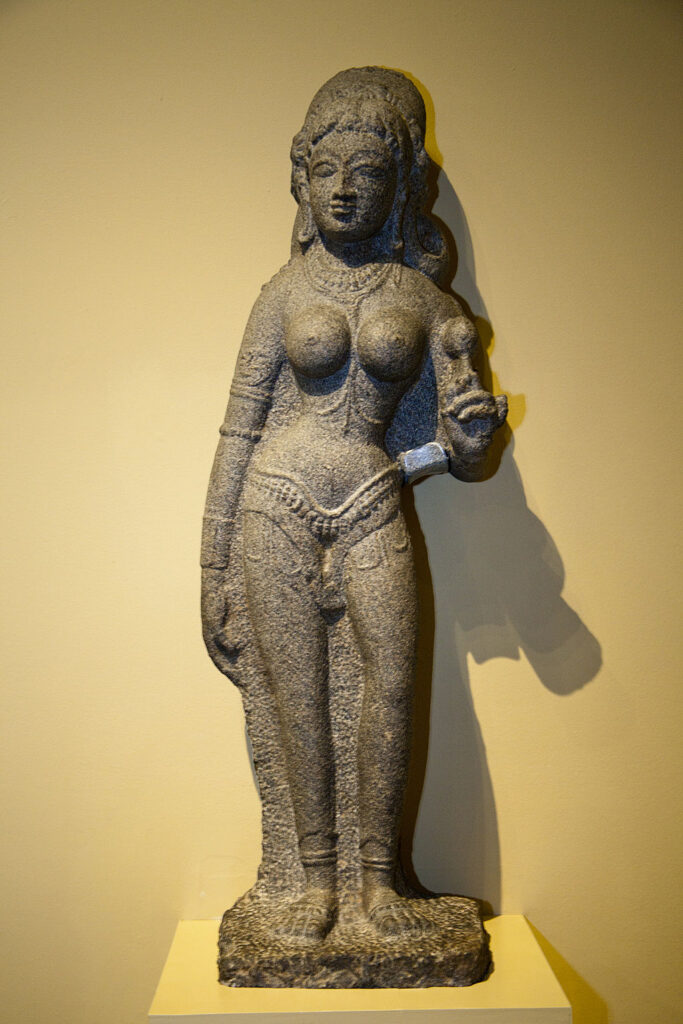
Crowds of monkeys and Rakshasas flooded the streets waiting to catch a glimpse of the princess. Seated on a palanquin behind a silk veil, Sita shone like the sun eclipsed by clouds. Sita was overjoyed to see Rama again. Her face glittered like the moon. But she was taken aback noticing Rama’s solemn expression. Rama feared that the citizens would raise questions about Sita’s chastity as she had spent a year at Ravana’s palace. Hence, keeping a stone in His heart, Rama conveyed that He was bound by duty to win back Sita. Now that He has avenged the insult by killing Ravana, Sita was free to go anywhere she pleased. Rama said that it would not be possible for Him to accept Sita as she had stayed with Ravana for so long.
Sita remained shocked hearing Rama’s words. She wept loudly, being shamed by her husband’s words. Sita tried to explain that she was helpless when Ravana abducted her. She was kept against her will in Lanka. Not for a moment had her heart deviated from Rama. Sita criticized Rama and questioned His judgment. Even Lakshmana was shocked. ‘How could Rama act in this way?’, he thought.
Sita turned to Lakshmana and asked him to raise a pyre. She wanted to enter the fire and give up her life. Receiving Rama’s nod, Lakshmana constructed a pyre. Sita prayed, “If I have never been unfaithful to Rama either in body, mind, or words, may fire god Agni save me. As my heart abides in Rama, may fire god protect me. As all gods are witness to my chastity, may fire god protect me ”. Saying thus, Sita fearlessly entered the fire. Rama became tearful. His mind was fixed on virtue, however His heart gave way to sorrow.
Even Brahma appeared in the sky and urged Rama to stop Sita. Rama bowed his head in respect but said nothing. Just then fire god Agni emerged from the pyre holding Sita. Agni placed Sita before Rama and testified to her chastity. Agni testified that Sita had never been unfaithful to Rama. Although she was held captive, her mind and heart always remained devoted to Rama. Hence Agni requested Rama to accept Sita.
A tearful Rama was overjoyed attending Agni’s testimony. He exclaimed that this purificatory ordeal was necessary or else the world would have labeled Him as foolish and lusty. Rama declared that Sita was inseparable from Him and accepted her with an open heart. Sita bloomed with happiness and sat next to Rama on a golden throne. The demigods and sages showered praises on Rama. Dasaratha Maharaja appeared in his celestial body and embraced Rama. He showered his blessings upon Sita.
Rama returns to Ayodhya
After crowning Vibhisana as the king of Lanka, Rama requested Indra to return the lives of all monkeys who had been killed in the battle. Accordingly, all the monkeys, even those whose limbs or heads have been severed, were brought back to life. The demi gods bid farewell. The monkeys camped for the night while Rama and Sita rested at Vibhisana’s palace. The next day, Rama expressed His desire to return quickly to Ayodhya. Vibhisana suggested that the Pushpaka chariot that Ravana had obtained from Kuvera could be used for the purpose. Rama was satisfied. He mounted the chariot along with Lakshmana and Sita. On His orders, the entire monkey army, along with Vibhisana and his kinfolks, also ascended the chariot. They were eager to witness Rama being crowned the emperor. The chariot stopped on its way at Kishkinda where the monkeys fetched their wives and kinfolks. The chariot then continued on its way. Rama then stopped at Bharadvaja muni’s ashrama where He sought the sage’s blessings. Rama sent Hanuman to Ayodhya as His messenger informing Bharata about Rama’s imminent arrival. Bharata and Shatrughna were overwhelmed with joy. A tearful Bharata wanted to award Hanuman with cows and riches for bearing the good news.

The news of Rama’s return spread like wildfire. The citizens left their homes and came out to welcome their beloved Ramachandra. Tumultuous blasts of conches and drum rolls were heard all around. Numerous other monarchs were also invited to Ayodhya by Bharata to attend Rama’s return. As the Pushpaka chariot landed in Ayodhya, Bharata and Shatrughna embraced Rama and Lakshmana. The monkeys along with Vibhisana and other guests were warmly welcomed at Ayodhya. Kaushalya, Sumitra, Kaikeyi, and other ladies were also present. The sages had also arrived to give their blessings.
Soon Rama was crowned the emperor of Ayodhya. Sixteen virgin girls consecrated Him as per the scriptural directions. The demigods were also witnessing this historical ceremony. Chants of ‘Victory to Rama’ echoed across the earth and skies.
Rama leaves Sita at Valmiki’s ashrama
As Rama ruled over Ayodhya, everything became auspicious. No one died prematurely and neither was there any fear of diseases. Every man was devoted to righteousness and was fully satisfied. Two years had passed since Rama’s coronation. Sita had now become pregnant. There was happiness and prosperity all around.
One day, while Rama was in the council hall, He enquired from His chief minister Bhadra, as to what the citizens thought about His rule. Bhadra replied that mostly people glorified Rama. They discussed His conquest of Lanka and the rescue of Sita. But Rama kept insisting and wanted to know if any negatives were also being spoken about Him. Bhadra took a deep breath and informed Rama that a handful of citizens also criticized Rama for accepting Sita although she had been kept by Ravana for one year. The citizens were heard saying that they would have to tolerate similar unchaste behavior from their wives, as Rama had allowed Sita back. Speaking thus, a tearful Bhadra gazed at the mosaic floor.
Rama stayed shocked. Sita’s purity had been testified by Agni. Yet the citizens continued to question Sita’s chastity. Rama dismissed the court and called for Lakshmana. Rama revealed to Lakshmana how the citizens were questioning Rama’s behavior. Rama wanted to avoid infamy by all means. Although Sita was dearer than His own life, Rama did not want to set a bad precedent. Hence He instructed Lakshmana to immediately take Sita into the forest and leave her at Sage Valmiki’s ashrama. Rama spoke gravely. Lakshmana was astonished to hear Rama’s words. Surely this was the most difficult task he had ever encountered.
Sita was unaware of the developments. She thought Rama had ordered Lakshmana so that Sita’s desire of visiting the forest was fulfilled. Reaching close to Valmiki’s ashrama, the three travelers got down. Lakshmana sighed deeply and let out a great cry. As Lakshmana revealed the truth about their visit, Sita stood shocked. She dropped to the ground with a piteous wail. Sita wanted to give up her life but only refrained thinking of Rama’s unborn child. Sita chose to stay back at Sage Valmiki’s hermitage considering that her abandonment was necessary to protect Rama from humiliation. Valmiki warmly welcomed Sita and entrusted her to the care of female ascetics.
Sita returns to the earth
In course of time, Sita gave birth to twins and named them Lava and Kusha. These boys had been lovingly raised by Valmiki who had trained them in scriptural knowledge and taught them Rama’s story. They became experts in reciting Ramayana, the story of the great Rama, composed by sage Valmiki. Lord Rama was enchanted to hear the recitation of Ramayana by Lava and Kusha. Although Rama was unaware of their identity, He could perceive that the twins were not ordinary. Hearing Ramayana, Rama longed to see Sita. Twelve years had passed since she left for the forest. Rama thought that the objective of sending Sita away had already been accomplished. Hence He ordered His ministers to summon Sita back. In the court, both Rama and Sita would take an oath that she had always remained pure, so that no further rumors circulated in the kingdom.
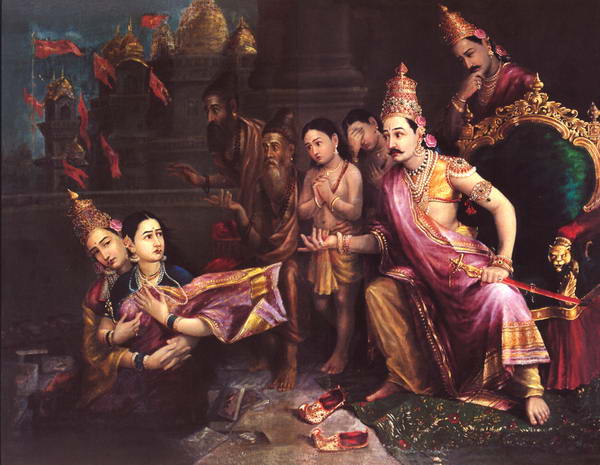
Accordingly, Sita was brought to the royal assembly the next morning. The vast arena was filled up with royalty, sages, and citizens. Representatives of Rakshasas, Gandharvas, and celestials had also arrived. First of all sage Valmiki testified to the chastity of Sita. He also conveyed that the twins Lava and Kusha, who had recited Ramayana the other day, were none other than Rama’s sons. Valmiki declared again and again that Sita had always remained dedicated to Rama.
Finally, Sita spoke with folded hands. She said, ‘If I have never thought about anyone other than Rama, may goddess earth grant me shelter. If I have only worshiped Rama in my mind, words and action may mother earth shelter me. If I have truthfully expressed that I only know of Rama as my Lord, let the earth receive me now’.
Sita felt that she had become a problem for Rama. As long as she remained, there would be those who would defame Rama. As Sita finished speaking, the ground next to her opened up and a celestial throne rose. Sitting on the throne was Bhumi (mother earth). She held out her hands for Sita. Sita caught her hand and sat next to her on the throne. The throne gradually reentered the earth. The Gods showered flowers as the kings and sages looked on in wonder. Everyone praised her chastity and devotion to Rama.
Rama turned angry and wanted to punish earth for taking Sita from Him. Brahma consoled Rama saying that everything was ultimately happening according to Rama’s own will. He would be united with Sita in the celestial realms. Rama became pacified.
Rama wraps up His pastimes
Rama had a gorgeous gold picture of Sita made by expert artisans. The statue sat next to Him in the royal court as He ruled over the kingdom. He did not even think of marrying again. He ruled the kingdom for eleven thousand years along with His brothers. The earth enjoyed unprecedented opulence during Rama’s reign. Religion was firmly established and everyone led pious lives.
Rama decided to wrap up His earthly pastimes. One day, Lakshmana knocked on Rama to inform Him of Durvasa’s arrival while Rama and death personified were conversing with one another. Death had previously warned that anyone who disturbed their meeting had to give up their life. Accordingly, Lakshmana bade farewell and gave up his life at the bank of the Sarayu river. When Rama decided to leave the world, Bharata and Shatrughna also wanted to wrap their earthly pastimes. Accordingly, Rama installed Lava and Kusha in the kingdom of Ayodhya. He wanted them to establish two capitals – one in the north and the other in the south.
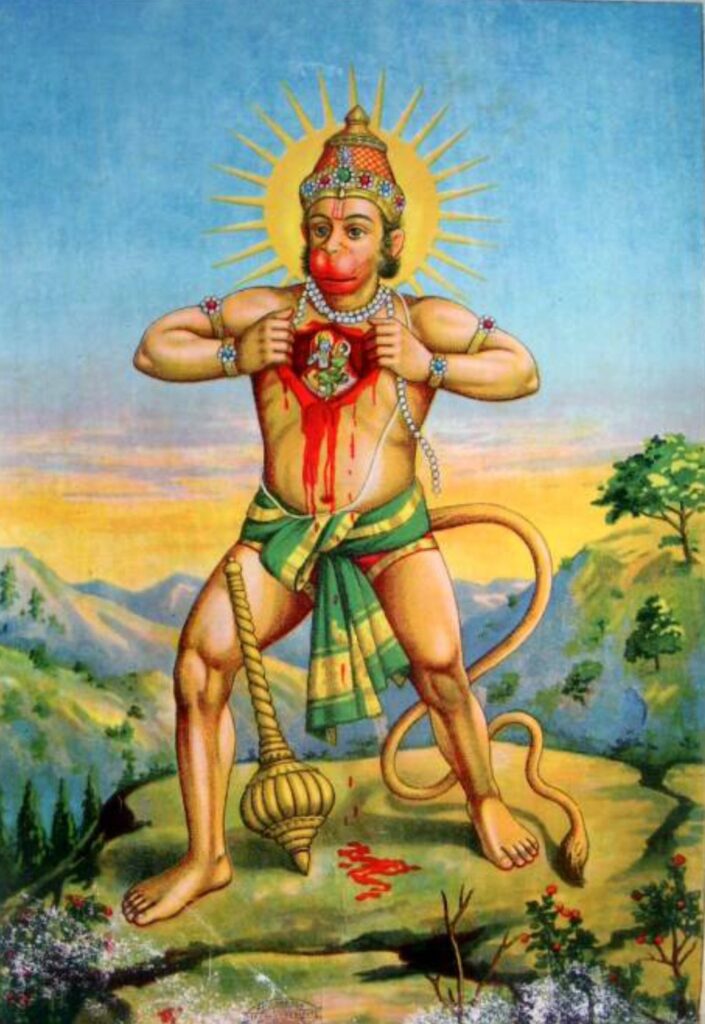
Rama met with Hanuman and the monkeys before leaving. Hanuman had decided to stay back on the earth and reside wherever the glories of Lord Rama were being chanted. Meeting with Vibhisana, Rama told him to worship Vishnu in the form of Lord Jagannath, the presiding deity of the Ikshvakus.
Finally, Rama and His two brothers merged with Vishnu’s form who had appeared on Garuda. Every creature who was absorbed in the thoughts of Rama then gave up his body and attained his spiritual form. In their celestial chariots, these devotees attained Rama’s imperishable spiritual abode. It appeared as if the whole city of Ayodhya went with Rama. Brahma and the other demigods were astonished to witness this unprecedented sight. Praising Rama within their hearts, they left for their abodes. All glories to Ramachandra, All glories to Sita, All glories to Lakshmana, all glories to Hanuman. Jaya Sri Rama!